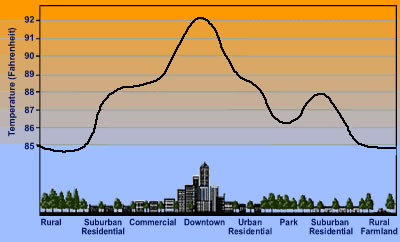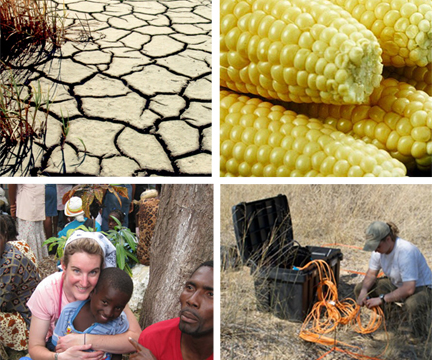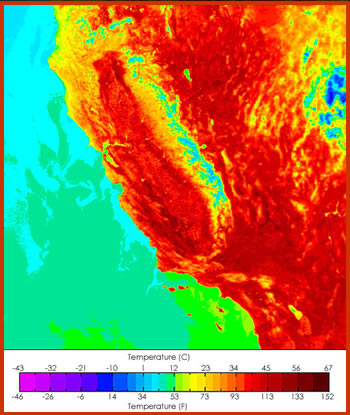This image, taken by the MODIS sensor on the Aqua satellite, shows the temperatures of California and Nevada during a spring heat wave in May 2004. MODIS (Moderate Resolution Imaging Spectroradiometer) measures the land temperature, which can get much warmer than the air. Notice that the tops of the Sierra Nevada mountains, which were still capped with snow, remain cool, forming a blue line at the California-Nevada border.
Click on image for full size
Courtesy of NASA
Heat Waves
Itís the middle of the summer and itís hot Ė hotter than normal. The heat lasts for days. Itís hot at night too.
Has that ever happened where you live? Unusually hot summer weather that lasts for several days is called a heat wave.
Not all heat waves are the same. Some have high humidity. Others do not. Some last for a week or more. Others last only a few days. Heat wave temperatures will be much hotter in a region that is usually hot than in a region that is usually cool. For example, temperatures during a heat wave in southern California, where summers are usually hot, may climb to 100-130°F (38-54°C), while temperatures during a heat wave in London, England, where summers are usually mild, may be only 90-95°F (32-35°C).
Heat waves are a danger to human health Ė causing heat stroke, heat exhaustion, cramps, and other ailments. They also cause crops to fail and can help start wildfires in dry areas.
How do they form? Sometimes, the jet stream, a flow of air through the mid-latitudes, can bring unusually warm air into a region. If the warm air stays put for a while, it can cause a heat wave. The heat is able to persist if there arenít rain and clouds to cool things off. The heat-trapping ability of cities, known as the urban heat island effect, can make a heat wave warmer and longer.
There are more heat waves today that there were in the past. According to the Intergovernmental Panel on Climate Change, the number of heat waves has risen, especially in Europe and Asia, and heat waves are expected to become more common during the this century.
Last modified July 15, 2009 by Lisa Gardiner.
You might also be interested in:

Rain is precipitation that falls to the Earth in drops of 5mm or more in diameter according to the US National Weather Service. Virga is rain that evaporates before reaching the ground. Raindrops form
...more
The air in urban areas can be 2 - 5įC (3.6 - 9įF) warmer than nearby rural areas. This is known as the urban heat island effect. Itís most noticeable when there is little wind. An urban heat island can
...more
We often take plants for granted. But they are so important! They give us food, paper, wood, even medicine. They also absorb carbon dioxide and release oxygen during photosynthesis. When big changes happen
...more
Over 100 years ago, people worldwide began burning more coal and oil for homes, factories, and transportation. Burning these fossil fuels releases carbon dioxide and other greenhouse gases into the atmosphere.
...more
Looking for online content that can be used for a climate change education course or module? Pages linked below can be used to support an introductory climate change education for either a unit or a full
...more
Rainbows appear in the sky when there is bright sunlight and rain. Sunlight is known as visible or white light and is actually a mixture of colors. Rainbows result from the refraction and reflection of
...more
The Earth travels around the sun one full time per year. During this year, the seasons change depending on the amount of sunlight reaching the surface and the Earth's tilt as it revolves around the sun.
...more















